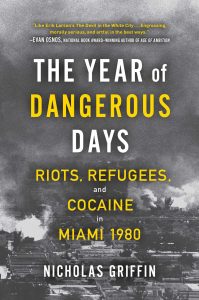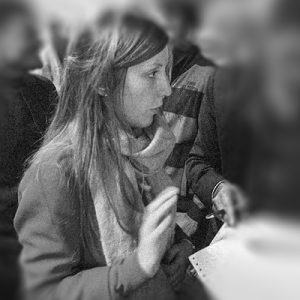APRIL 23, 1979
At noon, amid light traffic on the Florida Turnpike, a black Audi swerved at high speed attempting to outrun a Pontiac Grand Prix. The cars careened toward the end of the highway, where it dovetailed into Miami’s main thoroughfare, US 1, used by suburban southern Dade County to connect to the city. A man with thick sideburns leaned out the window of the Pontiac holding a revolver. He’d already blown out the back wind- shield of the Audi and sunk four more bullets into its chassis. Returning fire amid the shattered glass on the back seat of the Audi was a young man with a smudge of a mustache and long, dark hair whipping in the wind. Wearing a white dress shirt and crisp black slacks, he used both hands to fire an Ingram MAC-10 fitted with a suppressor.
Bewildered witnesses numbered in the dozens as the two cars decelerated and entered US 1. At the corner of Caribbean Boulevard the cars slowed long enough for a man to leap out of the passenger seat of the Audi. He positioned himself behind a traffic control box in front of the cowboy-themed cafeteria Westward Ho and raised a 9mm pistol to exchange fire with the Grand Prix as it returned to creep past him.
The chase only ended because a new one began. Officers in a passing patrol car spotted the three remaining armed men in the Audi. Flipping their lights and sirens on, they began a second high-speed pursuit on crowded US 1. The astonished policemen watched a man lean out of the rear of the Audi and spray their patrol car with machine-gun fire. Two miles later, the Audi pulled over close to a wooded area and the three men sprinted into the trees, untouched by police gunfire.
Panting and covered in scratches, one of the fugitives was soon captured wearing only a snug yellow bathing suit. Talking to the police in Spanish, he claimed he’d been jogging, become disorientated, and somehow lost his shoes. He was driven back to the Audi just in time to watch a crime-scene technician pop the trunk. Inside lay a corpse outfitted in brown, from socks to shoes, shirt to trousers. In contrasting stark white were the adhesive tape that covered his mouth and the 45 pounds of white powder pressed against his body in an open duffel bag. Moments later, the gunman who’d hidden himself behind the traffic control box was also found, nonchalantly browsing car parts in an automotive center while bleeding from a shoulder wound. He’d been watching through the window as police interviewed witnesses less than a hundred meters away.
It would be the first large investigation for the brand-new captain of the county homicide bureau, Marshall Frank. Previously, he had worked as a detective sergeant in homicide for seven years before leading the crime-scene section. A heavy smoker, Frank dressed in J. C. Penney suits and aviator sunglasses and carried a small bottle of Old Spice in his pocket alongside a handkerchief to mask the heavy stench of Florida decompositions.
A week into the investigation, Frank received a kind note from State Attorney Janet Reno, congratulating him on his department’s performance. Seven days later brought a swing in mood. A grand jury had refused to indict either of Frank’s suspects on murder, citing a lack of prosecutorial evidence. “It has come to my attention that the Department now considers this to be a case of second order priority,” Reno wrote, reminding Frank that if the murder case wasn’t brought to trial within one hundred and eighty days of the arrest, both men would automatically receive immunity. Frank, she chided, needed to force his detectives to develop the evidence and tie the suspects directly to the body.
The investigative files doubled in thickness and doubled again. Eighty-one leads were pursued that led Frank’s men to stolen cars, a murdered maid, abduction, aggravated assaults, immigration offenses, organized crime, and concealed firearms. Yet despite the combined efforts of Reno and Frank, the grand jury still refused to indict the suspects on anything other than weapons violations and assault charges.
Within a month on the job, Marshall Frank began to understand how difficult a post he had been handed. It came with pressure from the state attorney and from Miami’s news media. The body in the trunk wasn’t a simple murder. It involved a fledgling cocaine industry, illegal immigration, and violent acts executed in public. What Frank couldn’t yet understand was that the case also concerned corruption. The Federal Bureau of Investigation was involved. The Bureau had opened a secret investigation before Frank had even arrived. While Marshall Frank joined Reno in worrying about the rising number of fatalities in the county, the FBI worried that the 45 pounds of milk sugar found in the back of the trunk had been placed there by Frank’s detectives to conceal their theft of an equal amount of cocaine.
Was the homicide bureau itself corrupt? Miami would have little else to lean on if Janet Reno was correct in her belief that the county’s murder rate was beginning an unusual acceleration. Still, in the middle of 1979, it was very hard to guess at the extent of Miami’s looming crisis.
From Capt. Marshall Frank’s point of view, the highway shootout was a presumed anomaly. Miami had seen nothing like it before. The idea that criminals would take such extraordinary risks in public again was nonsensical. Not even the finest homicide detective can determine a pattern from a single instance, but in retrospect, Miami was about to pose new problems and new questions for the rest of America to consider.
Within the year, drugs would become a part of the national conversation. Immigration would evolve into a virulent topic in South Florida as race was redefined in Miami. Dade County not only witnessed what the New York Times called the worst racial disturbances of the century but would behold something entirely new: enough Latin Americans suddenly spilling into a city to turn both black and white citizens into minorities.
Miami’s suffering was to become so obvious in 1980 that its own leaders questioned its survival.These fluid American issues of race, immigration, and drugs would mainly be seen as South Florida’s problems. In the coming hinge year, few thought of a future for Miami as bright as today’s twenty-three million visitors, thriving service industries, vast port, and iridescent skyline. Miami’s suffering was to become so obvious in 1980 that its own leaders questioned its survival.
Most presume that the city’s embrace of Latin American culture was a strength embedded in Miami’s DNA, a natural consequence of history, geography, and planning. It’s far from the truth. Today’s city accelerated into being out of a traumatic 1980. There was little planning, little history, to build on. Geography seemed to be conspiring against the city, not working for it. The more closely you look at 1980, the more remarkable Miami’s transformation into an aspiring international metropolis becomes.


















